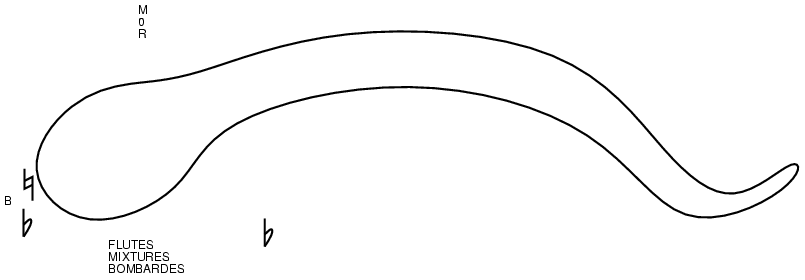
But you don't have to blow into it, because it breathes water, not air.
When you block one of the water jets, a note is sounded.
Most "snakes" are tuned to a diatonic scale, in the key of A-minor. Therefore, running your fingers down the first eight vertebrae of the snake's back, starting at her head, will result in a natural minor scale.
If you want to play a major scale, you simply begin on the third water jet ("C"), rather than the first jet ("A").
Sharps and flats are played using "snake" embouchure.
The lowest note, usually "A", is located at the fattest part of the snake's body, near the snake's "head". There is usually an opening at that end, to allow water to enter.
Partial blocking of the jets will not change the pitch or timbre very much, but will simply result in reduced volume (sound level). Although you may be able to invoke a slight flattening of the sound (in addition to volume reduction), the best way to bring expression into the sound of the snake is with the embouchure of the instrument.
When playing the snake from a garden hose, there is less opportunity for embouchure expression control, except by stepping on the hose to change the water flow (or by using a foot-operated flow-control valve), and a small number of other tricks you can play.
However, there are versions of the hydraulophone that have various expression valves so that they can be played outside a body of water, such as in a garden. These are called "garden snakes".
If you play the standard snake in a pool, lake, or hot tub, you have much more control over the embouchure.
Getting into the swim of things, since the head is located to your left, you play the instrument by rotating the snake counter-clockwise in the water, so that water goes into her mouth, and comes out the holes in her vertebrae. Continue to swirl her in a counter-clockwise circle as you play, while keeping a steady flow of water running into her mouth.
When the snake's body is in the water, she sings a sweeter, more mellow tone than when she's played on land.
To dampen the vibrations, you simply push her deeper into the water. To brighten the sound, you simply raise her up, ease off, let her float up more, etc..
You can change the sound alot by the way you control which parts of her body are under the water. The biggest changes come from how much of her head, especially her mouth, is under water. Yaw, pitch, and roll all affect the sound expression in different ways. As you experiment with the sound, you will likely find that an easy way to remember expression control is "UP UP AND AWAY". As her body is moved more "up and away", the sound will be more "up" in volume (lounder), as well as more full and rich in timbre.
But don't get too carried away, or she'll run dry, lose her prime, and eventually fall silent, if her head is brought up too high in the water.
Snakes are designed to hold a large reserve capacity of water, to even out fluctuations in flow. Therefore you can "get away with" some fairly big bursty changes in expression. After a while, you will begin to understand what the limitations are, and be able to push these limits.
Have fun!
The KEY to good music is to PLAY in the water.
